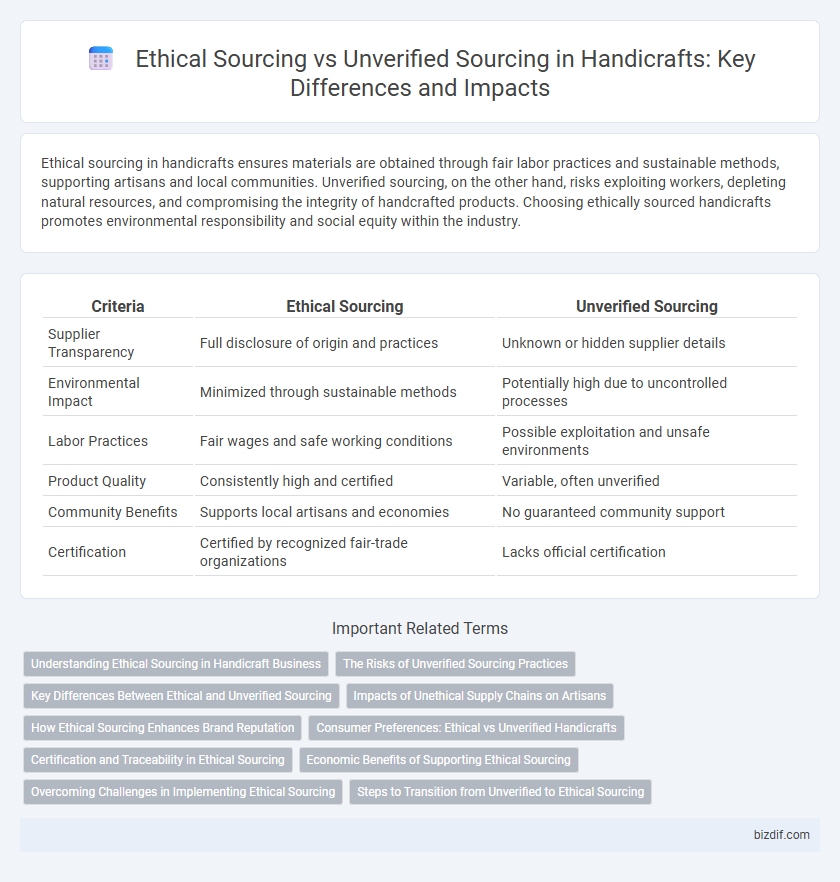Ethical sourcing in handicrafts ensures materials are obtained through fair labor practices and sustainable methods, supporting artisans and local communities. Unverified sourcing, on the other hand, risks exploiting workers, depleting natural resources, and compromising the integrity of handcrafted products. Choosing ethically sourced handicrafts promotes environmental responsibility and social equity within the industry.
Table of Comparison
| Criteria | Ethical Sourcing | Unverified Sourcing |
|---|---|---|
| Supplier Transparency | Full disclosure of origin and practices | Unknown or hidden supplier details |
| Environmental Impact | Minimized through sustainable methods | Potentially high due to uncontrolled processes |
| Labor Practices | Fair wages and safe working conditions | Possible exploitation and unsafe environments |
| Product Quality | Consistently high and certified | Variable, often unverified |
| Community Benefits | Supports local artisans and economies | No guaranteed community support |
| Certification | Certified by recognized fair-trade organizations | Lacks official certification |
Understanding Ethical Sourcing in Handicraft Business
Ethical sourcing in the handicraft business ensures materials and labor are obtained through fair trade practices, supporting artisans' rights and environmental sustainability. This approach promotes transparency, traceability, and fair wages, contrasting with unverified sourcing that may involve exploitation and environmental harm. Businesses adopting ethical sourcing build trust and long-term value by prioritizing social responsibility and authentic craftsmanship.
The Risks of Unverified Sourcing Practices
Unverified sourcing practices in handicraft production pose significant risks, including the potential for child labor, exploitation of artisans, and environmental damage. Lack of transparency in supply chains can lead to the use of illegally sourced materials, undermining fair trade principles and consumer trust. Ethical sourcing mitigates these risks by ensuring fair wages, sustainable materials, and verified artisan working conditions.
Key Differences Between Ethical and Unverified Sourcing
Ethical sourcing in handicrafts ensures materials are obtained through fair labor practices, sustainable methods, and transparency in the supply chain, promoting social and environmental responsibility. Unverified sourcing lacks accountability, often involving exploitative labor, non-sustainable resources, and opaque procurement processes, leading to ethical and ecological risks. Key differences include traceability, worker welfare, and environmental impact, with ethical sourcing prioritizing certifications and community empowerment.
Impacts of Unethical Supply Chains on Artisans
Unverified sourcing in handicraft supply chains often leads to exploitative labor practices, low wages, and unsafe working conditions for artisans. This lack of transparency can perpetuate income inequality and hinder the preservation of traditional crafts. Ethical sourcing prioritizes fair trade principles, ensuring artisans receive equitable compensation and fostering sustainable cultural heritage.
How Ethical Sourcing Enhances Brand Reputation
Ethical sourcing in handicraft ensures materials and labor are responsibly obtained, promoting fair wages and environmentally friendly practices that resonate with socially conscious consumers. Brands committed to ethical sourcing build trust and loyalty by transparently supporting artisans and sustainable communities, which enhances their reputation in competitive markets. In contrast, unverified sourcing risks brand credibility due to potential associations with exploitation or environmental harm, undermining customer confidence and long-term business success.
Consumer Preferences: Ethical vs Unverified Handicrafts
Consumers increasingly prioritize ethical sourcing in handicrafts, valuing fair labor practices, sustainable materials, and transparent supply chains. Unverified sourcing often raises concerns about exploitation, environmental harm, and product authenticity, leading to decreased consumer trust. Market data shows that 70% of buyers prefer ethically sourced handicrafts, driving brands to adopt certification standards and promote responsible craftsmanship.
Certification and Traceability in Ethical Sourcing
Ethical sourcing in handicrafts emphasizes certification and traceability to ensure materials and labor meet established social and environmental standards, such as Fair Trade or Global Organic Textile Standard (GOTS). Certified supply chains provide transparency, allowing consumers to verify origins and ethical compliance, which helps prevent exploitation and supports sustainable development. In contrast, unverified sourcing lacks documentation and oversight, increasing risks of unethical practices and undermining consumer trust.
Economic Benefits of Supporting Ethical Sourcing
Supporting ethical sourcing in handicrafts ensures fair wages and safe working conditions for artisans, directly contributing to sustainable economic growth in local communities. Ethical sourcing increases consumer trust and brand loyalty, boosting long-term sales and market stability. Unverified sourcing risks exploitation and unstable supply chains, undermining economic benefits and damaging brand reputation.
Overcoming Challenges in Implementing Ethical Sourcing
Ethical sourcing in handicrafts prioritizes fair wages, sustainable materials, and transparent supply chains, contrasting sharply with unverified sourcing that often risks exploitation and environmental harm. Overcoming challenges in implementing ethical sourcing involves establishing rigorous supplier audits, fostering long-term partnerships with artisans, and investing in traceability technologies like blockchain. These strategies ensure accountability, enhance product authenticity, and promote social responsibility within the handicraft industry.
Steps to Transition from Unverified to Ethical Sourcing
Transitioning from unverified to ethical sourcing begins with conducting comprehensive supplier audits to assess labor conditions, environmental impact, and fair trade compliance. Implementing transparent supply chain tracking systems ensures accountability and fosters trust among artisans and consumers. Establishing long-term partnerships with certified fair-trade suppliers promotes sustainable livelihoods and supports the preservation of traditional handicraft techniques.
Ethical sourcing vs Unverified sourcing Infographic

 bizdif.com
bizdif.com